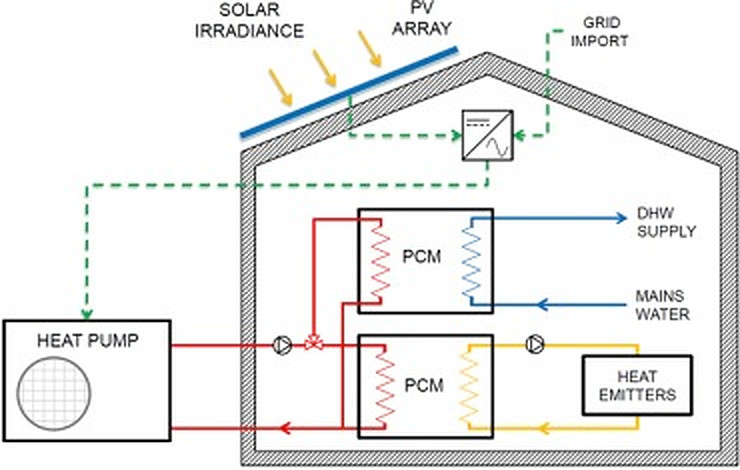Imperial College London scientists have designed an air-source heat pump system (ASHP) to provide space heating (SH) and domestic hot water (DHW) for single-family dwellings, powered by solar.
“The first novelty of this work lies in the development of comprehensive thermal network models for a typical house for two different system configurations,” they said.
The two configurations consist of a standard heat pump system coupled with a hot-water cylinder and an advanced configuration featuring a heat pump system paired with two phase-change material (PCM) thermal storage systems. PCMs can absorb, store and release large amounts of latent heat over defined temperature ranges. They have often been used at the research level for PV module cooling and the storage of heat.
“Thermal storage volumes typical of heat pump products for small- or medium-sized dwellings (200 L) are assumed for the two configurations, aiming to demonstrate whether economic savings can be achieved even in the presence of significant space limitations,” the scientists explained, noting that they used data sheets from different manufacturers to develop performance models of the PV and heat pump systems. “Another contribution of this work is that all scenarios are conducted for two different, carefully selected, locations: Oban in Scotland, UK, a location which experiences low solar irradiance and mild temperatures, and Munich in Southern Germany, which is a sunny location with large diurnal and seasonal temperature variations.”
The first system configuration features an ASHP, including a backup electric heater, an array of heat emitters, a hot-water cylinder and a PV system. The latter is only used to power the heat pump, while the remaining power is taken from the grid.
The second system design includes an ASHP, two separate PCM thermal stores, an array of heat emitters, and a PV array.
“The main differences to the first configuration are that the hot-water cylinder has been replaced by a PCM thermal store and the ASHP does not provide SH directly, as a second PCM thermal store acts as a buffer between heat supplied by the ASHP and SH demand,” the researchers explained.
They estimated DHW demand for a single-week probabilistic demand profile, with the reference supply temperature being 43 C. They described this as the typical range for baths, showers, and other domestic hot-water applications.
They developed the system with a heat pump with a nominal heating capacity of 8.5 kW and a minimum heating capacity of 3.2 kW in both configurations. The backup electric heater has a fixed output of 3 kW and the PV system relies on eight panels with a combined area of 13 square meters. They compared the systems with that of an unoptimized baseline case, which was taken to be the standard configuration.
“The work involved the development of comprehensive thermal network models for a typical house,” the academics said.
They found that the system with the two PCM thermal stores offered the best potential for cost savings, which they estimated at up to 39% per year in the United Kingdom and at 29% in Germany.
“Depending on the objective function, configuration and location, the system seasonal coefficient of performance (COP) varies between 2.4 and 2.8,” they said.
They described the systems in “Operational optimization of an air-source heat pump system with thermal energy storage for domestic applications,” which was recently published in Energy Conversion and Management. They claim that operational costs can be lowered by avoiding peak electricity-price hours.
This content is protected by copyright and may not be reused. If you want to cooperate with us and would like to reuse some of our content, please contact: editors@pv-magazine.com.




How very unoriginal. In 2019 working with some students I developed variosu thermal models for houses (with varying levels of insulation). We then developed a model for the residential sector of houses connected to a distribution transformer (150 to 250 households to a 500kVA tx) and with varying levels of insualtion. We then modelled for heat pumps (circa 25% penetration and voltage levels fall out of statutory), PV, fuel cells (helps HP penetration) and EVs. PV helps a bit in spring and autumn but is useless in winter. Doing a community energy scheme @ the moment – 220 households – 1970s – 1980s build, most of them too small for a heat pump (we know – we have surveyed them). Increasingly, I wonder about the value of academic research – the subjects seem to be increasingly trivial and unoriginal. In the unlikely event that Imperial can be bothered to contact me – I’d be happy to discuss our findings.
Here you’ll find another recent PV-magazine article on the demo of such a PV + heat pump + heat storage concept for an office buiding in Norway: https://www.pv-magazine.com/2022/10/17/pcm-based-thermal-battery-to-store-solar-power-via-heat-pump/